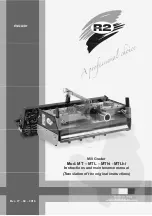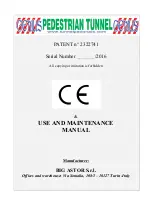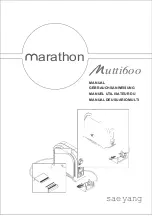
Who should be testing socket outlets?
Basically anyone who wants to know the mains socket
about to be used is correctly wired and safe to plug into.
In particular those with a responsibility of care for their
own homes, employees and the public.
•
Home owners
•
Land lords
•
Local authorities
•
Police forces
•
Hospitals, including home visits
•
Schools and colleges
•
Sports facilities
•
Military housing and education
•
IT managers
•
Heads of department
•
Health and Safety officers
Loopcheck 107
Advanced socket
tester with loop
function
Your guide to easy
Socket Outlet Testing
and instructions for use of:
BS EN
61010-1
Caution
Before use check the socket tester's case and pins for
any signs of damage.
Do not use if the case is broken or damaged. To check
the correct functioning of the socket tester, plug it into
a known correctly-wired live 13A socket.
To clean the tester use only a soft dry cloth.
This unit is maintenance free and contains no user
serviceable components. In the unlikely event that this
unit malfunctions, it should be withdrawn from service
and returned to Kewtech.
This tester must not be used in a manner not specified
by Kewtech.
Good work practice
Use of a Socket Tester will be seen to show a
responsible attitude to electrical safety, plus the very
reasonable price of Kewtech testers means they place a
cost effective solution in the hands of many more users
at the front end of responsibility and care.
kewtechcorp.com
The simple solution for testing
socket outlets
Logical ‘Green
for Go’
Bright, easy to read
LEDs
Clear audible
indication
Error free testing
What a Kewtech tester WILL
tell you
The Loopcheck 107 is unique in that it is the only
socket tester that carries out a loop test at mains
frequency to check the actual condition of the wiring.
Particular emphasis is placed on detecting very
dangerous wiring conditions such as reversed line
(live) earth connections, disconnected wires and high
earth values.
What a Kewtech tester will NOT
tell you
Kewtech socket testers are for simple first line
diagnosis for use by those with and without electrical
skills. If a problem at the socket is shown it should
immediately be investigated by a suitably qualified
electrician or contractor recognised by organisations
such as:
NAPIT (www.napit.org.uk)
NICEIC (www.niceic.com)
ECA (www.eca.co.uk)
ECA of Scotland (www.select.org.uk)
STROMA (www.stroma.com)
Product features
•
Bright, durable LEDs out-perform fragile, low
visibility neons
•
Patented ‘Fault Locate’ shows actual position of
Pin – Line (Live), Neutral or Earth
•
Unique new Earth Loop Test
•
Tough, smooth-contoured construction
•
Rubber overmould tactile case
•
Advanced electronic circuits mean positive and
reliable indication
•
Modern production methods ensure great
performance and value
•
Audible signal gives additional information
•
Microprocessor control with built-in self check
230V 13 amp BS 1363 Socket Testers with
self-check and patented ‘Fault Locate’ plus
Earth check
•
First Socket Tester to indicate actual fault location
– Line (live), Neutral or Earth
•
Unique earth loop test at mains frequency to
check the actual condition of the wiring
•
Built-in automatic visible self-check ensures total
confidence in correct functioning at all times
•
Tri-coloured LEDs (green, red, orange) give clear
and positive indication of Good wiring plus
17 possible fault conditions
•
Mains polarity check
•
30mA RCD check
This is an example of
the Earth Loop Test
showing green – good,
less than 1.8Ω.
This is an example of
‘Fault Locate’ showing
line (live), neutral,
reverse. LEDs flash red
plus warble tone.
Specifications
Socket wiring check
Three green LEDs and a continuous tone indicate that the
socket is correctly wired. Earth, Line (Live) and neutral
are all in the correct position. Any other indication, such
as open circuit or swapped connections, is shown by
an orange or red LED accompanied by a warble tone.
The socket is incorrectly wired and all further tests are
inhibited.
Note: Like all socket (and other similar) testers a neutral
– earth swap cannot be detected unless the distribution
board is fitted with an RCD in which case the RCD will trip.
Socket condition check
This is carried out by injecting a loop impedance test
current between line (live) and neutral and also between
neutral and earth. If during the pre-test there is an
indication the earthed metal work could raise to touch
voltage of greater than 25V the test is inhibited.
Mains Polarity test
This is a capacitively coupled pad. The user is the earth
reference point for true earth.
This test is used to indicate that there is not a line (live)
neutral swap of the mains supply at the supply entry point
to the premises.
RCD test (30mA RCD only)
Operation of the test switch injects a test current of
30mA Line (Live) to earth to provide an operational check
for the RCD. The test current is restricted to 300ms.
The result is shown by one of three LEDs.
Rating 230V. Input current: <18mA (L–E <7mA)
Frequency: 50Hz.
Suitable for use in environmental conditions:
Temperature 0–40˚C
Humidity: <95% non-condensing
This tester is not intended for continuous use – do not
leave connected in a socket for longer than 2 minutes.
Indication LED Tone
Good
Green
Continuous
Check
Amber
Warble
Urgent Check
Red
Warble




















